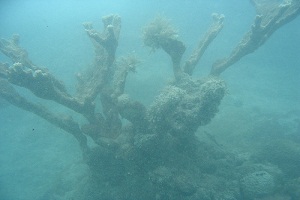http://www.ncbi.nlm.nih.gov/pubmed/22682583
Mar Pollut Bull. 2012 Sep;64(9):1737-65. doi: 10.1016/j.marpolbul.2012.05.008. Epub 2012 Jun 7.
This is another study available only for a price, but the abstract is instructive to the issue of how dredging harms corals. DV
Sinclair Knight Merz (SKM), P.O. Box H615, Perth, WA 6001, Australia. perftemeijer@globalskm.com
Abstract
A review of published literature on the sensitivity of corals to turbidity and sedimentation is presented, with an emphasis on the effects of dredging. The risks and severity of impact from dredging (and other sediment disturbances) on corals are primarily related to the intensity, duration and frequency of exposure to increased turbidity and sedimentation. The sensitivity of a coral reef to dredging impacts and its ability to recover depend on the antecedent ecological conditions of the reef, its resilience and the ambient conditions normally experienced. Effects of sediment stress have so far been investigated in 89 coral species (~10% of all known reef-building corals). Results of these investigations have provided a generic understanding of tolerance levels, response mechanisms, adaptations and threshold levels of corals to the effects of natural and anthropogenic sediment disturbances. Coral polyps undergo stress from high suspended-sediment concentrations and the subsequent effects on light attenuation which affect their algal symbionts. Minimum light requirements of corals range from <1% to as much as 60% of surface irradiance. Reported tolerance limits of coral reef systems for chronic suspended-sediment concentrations range from <10 mg L(-1) in pristine offshore reef areas to >100 mg L(-1) in marginal nearshore reefs. Some individual coral species can tolerate short-term exposure (days) to suspended-sediment concentrations as high as 1000 mg L(-1) while others show mortality after exposure (weeks) to concentrations as low as 30 mg L(-1). The duration that corals can survive high turbidities ranges from several days (sensitive species) to at least 5-6 weeks (tolerant species). Increased sedimentation can cause smothering and burial of coral polyps, shading, tissue necrosis and population explosions of bacteria in coral mucus. Fine sediments tend to have greater effects on corals than coarse sediments. Turbidity and sedimentation also reduce the recruitment, survival and settlement of coral larvae. Maximum sedimentation rates that can be tolerated by different corals range from <10 mg cm(-2) d(-1) to >400 mg cm(-2) d(-1). The durations that corals can survive high sedimentation rates range from <24 h for sensitive species to a few weeks (>4 weeks of high sedimentation or >14 days complete burial) for very tolerant species. Hypotheses to explain substantial differences in sensitivity between different coral species include the growth form of coral colonies and the size of the coral polyp or calyx. The validity of these hypotheses was tested on the basis of 77 published studies on the effects of turbidity and sedimentation on 89 coral species. The results of this analysis reveal a significant relationship of coral sensitivity to turbidity and sedimentation with growth form, but not with calyx size. Some of the variation in sensitivities reported in the literature may have been caused by differences in the type and particle size of sediments applied in experiments. The ability of many corals (in varying degrees) to actively reject sediment through polyp inflation, mucus production, ciliary and tentacular action (at considerable energetic cost), as well as intraspecific morphological variation and the mobility of free-living mushroom corals, further contribute to the observed differences. Given the wide range of sensitivity levels among coral species and in baseline water quality conditions among reefs, meaningful criteria to limit the extent and turbidity of dredging plumes and their effects on corals will always require site-specific evaluations, taking into account the species assemblage present at the site and the natural variability of local background turbidity and sedimentation.
